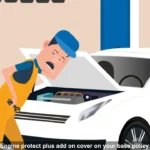Car insurance is an essential part of responsible vehicle ownership, but understanding the intricacies of a car insurance policy document can be daunting. This comprehensive guide aims to demystify the various components of a car insurance policy, helping you make informed decisions and ensuring you are adequately protected.
Introduction to Car Insurance Policy Documents
A car insurance policy document is a legal contract between the insurer and the insured, outlining the terms and conditions under which the insurer agrees to compensate for losses incurred due to specific events. It is crucial to comprehend each section of this document to avoid any unpleasant surprises in the event of a claim.
Key Components of a Car Insurance Policy
Declarations Page
The declarations page, often referred to as the “dec page”, provides a summary of your car insurance policy. It includes essential details such as:
- Policyholder’s Information: Name, address, and contact details of the insured.
- Vehicle Information: Make, model, year, and VIN (Vehicle Identification Number) of the insured vehicle.
- Policy Period: The start and end dates of the coverage.
- Coverage Types and Limits: A breakdown of the different coverages included in the policy and their respective limits.
- Premium: The amount you need to pay for the insurance coverage.

Insuring Agreement
This section outlines the insurer’s promise to pay for covered losses. It specifies:
- Coverage Types: Including liability, collision, comprehensive, personal injury protection (PIP), and uninsured/underinsured motorist coverage.
- Policy Limits: The maximum amount the insurer will pay for each type of coverage.
Definitions
To avoid misunderstandings, the policy document includes a section defining key terms used throughout the document. Familiarize yourself with these definitions to fully understand your coverage.
Coverages and Limits
Liability Coverage
Liability coverage is mandatory in most states and covers damages you are legally responsible for if you cause an accident. It is divided into two main parts:
- Bodily Injury Liability: Covers medical expenses, lost wages, and legal fees if you are at fault in an accident that injures someone else.
- Property Damage Liability: Covers the cost of repairing or replacing the other party’s vehicle or property.
Collision Coverage
Collision coverage pays for damages to your vehicle resulting from a collision with another vehicle or object, regardless of who is at fault. This coverage is particularly important if you have a newer or valuable car.
Comprehensive Coverage
Comprehensive coverage protects against non-collision-related damages, such as theft, vandalism, natural disasters, and animal strikes. This coverage is essential for safeguarding your vehicle against a wide range of risks.
Personal Injury Protection (PIP)
Personal Injury Protection (PIP), also known as no-fault insurance, covers medical expenses and lost wages for you and your passengers, regardless of who is at fault in an accident. PIP coverage can vary significantly by state, so it’s important to review your policy details carefully.
Uninsured/Underinsured Motorist Coverage
Uninsured/underinsured motorist coverage protects you if you are involved in an accident with a driver who either has no insurance or insufficient coverage. This type of coverage ensures that you are not left with substantial out-of-pocket expenses.
Exclusions
The exclusions section lists situations and circumstances that are not covered by your policy. Common exclusions include:
- Intentional Damage: Any damage you cause intentionally.
- Wear and Tear: Normal wear and tear or mechanical breakdowns.
- Commercial Use: Using your vehicle for commercial purposes, unless specified in the policy.
- Non-Permissive Use: Damages incurred when someone uses your vehicle without permission.
Understanding these exclusions is vital to avoid unexpected coverage denials.
Conditions
The conditions section outlines the responsibilities of both the insurer and the insured. Key conditions include:
- Premium Payments: Timely payment of premiums to keep the policy active.
- Notice of Loss: Prompt notification to the insurer in the event of an accident or loss.
- Cooperation: Requirement to cooperate with the insurer during the claims process.
- Proof of Loss: Submission of necessary documentation to substantiate a claim.
Endorsements and Riders
Endorsements and riders are additional provisions that can modify the standard coverage of your policy. These can include:
- Roadside Assistance: Coverage for towing and other emergency services.
- Rental Reimbursement: Coverage for rental car expenses while your vehicle is being repaired.
- Gap Insurance: Covers the difference between the actual cash value of your vehicle and the amount you owe on your car loan or lease.
Reviewing these endorsements can help you customize your policy to better meet your needs.
Tips for Reviewing Your Car Insurance Policy Document
Read the Entire Document
While it may be tempting to skim through your policy, reading the entire document thoroughly is essential. Pay close attention to the details to ensure you understand what is covered and what is not.
Ask Questions
If any part of the policy is unclear, do not hesitate to ask your insurance agent for clarification. Understanding your coverage fully can prevent confusion and frustration during the claims process.
Regularly Review and Update Your Policy
Your insurance needs can change over time. Regularly reviewing and updating your policy ensures that your coverage remains adequate and relevant to your current situation.
Compare Policies
It’s wise to compare policies from different insurers periodically. Doing so can help you find better coverage options or more competitive rates.
Conclusion
A car insurance policy document is a complex but crucial tool for protecting yourself and your vehicle. By understanding the various components of your policy, you can make informed decisions and ensure you have the coverage you need. Remember to review your policy regularly, ask questions when necessary, and consider adding endorsements that provide additional protection.
If you want to read more information about how to boost traffic on your Website just visit –> The Insider’s Views.



